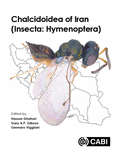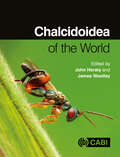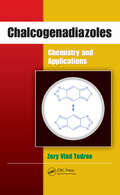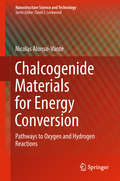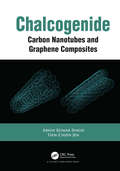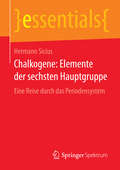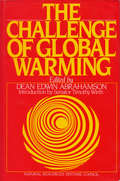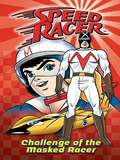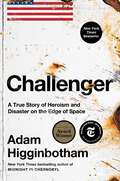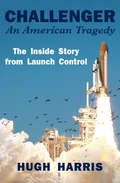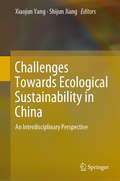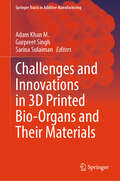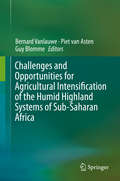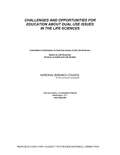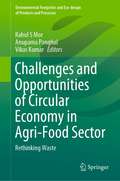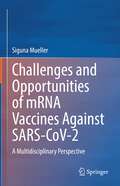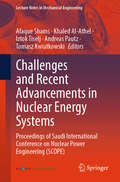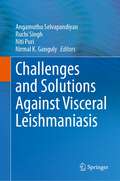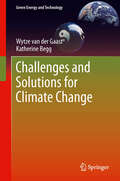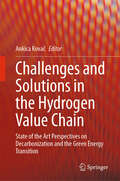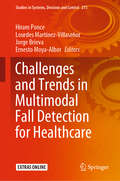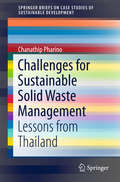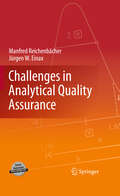- Table View
- List View
Chalcidoidea of Iran (Insecta: Hymenoptera)
by Hassan Ghahari Gary A.P. Gibson Gennaro ViggianiThe superfamily Chalcidoidea (Insecta, Hymenoptera) contains in excess of 26,000 described species worldwide, but with an estimated total diversity of more than 500,000 species the vast majority of species have yet to be discovered and described. Most chalcidoid species are parasitoids of hosts in at least 12 different insect orders, attacking the egg, larval or pupal stages, though phytophagy and other life cycles and hosts are known. Iran is the 18th largest country in the world and has a rich and diverse insect fauna, including Chalcidoidea. It is extremely interesting from a biogeographic point of view, and a paradise for an entomologist. This book summarizes the results of all prior research concerning species diversity of Iranian Chalcidoidea, including host records and distribution records by province in Iran as well as world distribution by country for 1,351 species of Chalcidoidea recorded from Iran through the end of 2019. The faunal diversity for each of the 20 families of Chalcidoidea known from Iran is also compared with that known for 15 adjacent countries. In addition, general information on world diversity, recognition, phylogenetic relationships and host relationships are given for each family. As such, the book will be an invaluable source of information for all those involved with chalcidoids, for anyone with an interest in insect systematics, and all those working in crop protection, especially biological control and Integrated Pest Management.
Chalcidoidea of the World
The superfamily Chalcidoidea (the jewel wasps) are part of the insect order Hymenoptera. The superfamily comprises more than 27,000 known species, with an estimated total diversity of more than 500,000 species, meaning that the vast majority have yet to be discovered and described. Most of the species are parasitoids, attacking the egg, larval stage or pupal stage of their host, though many other life cycles are known including gall associates and fig pollinators. This landmark volume has been co-authored by world authorities on the systematics and biology of chalcidoid wasps. It provides an introduction to the superfamily, a review of chalcidoid morphology, an overview of the fossil record, a phylogenetic framework for the revised classification of the superfamily, an identification key for the 50 recognized families, and detailed treatments of the individual families. The book consolidates much recent research on the phylogenomics of Chalcidoidea and the fossil record. This research has resulted in substantial changes to their classification, and in a review of all families, the new family groups are presented to the general scientific public for the first time. The book is an historic milestone, presenting a reclassification of the superfamily and a synthesis of knowledge on all aspects of Chalcidoidea that will serve for generations to come. Individual chapters clarify the limits of families and subfamilies based on contemporary phylogenetic studies. These chapters provide for each family: diagnostic features and extensively illustrated details of their specialized morphology, summaries of their distribution and worldwide diversity, a history of their classification history and major workers, phylogenetic relationships, natural history, use in biological control and economic impact, fossil history, and fully illustrated identification keys to subfamilies or in some cases to genera. Additional chapters present best practices for collecting, rearing from hosts, and preservation, review digital resources currently available, explore the diversity of their natural history and their human impacts, such as their use and importance to biological and natural control of pest arthropods. Chapters by worldwide authorities explore the enormous biological diversity of chalcidoid wasps including consequences of their almost unbelievable miniaturization (the most extreme known in insects), relationships with endosymbionts, special aspects of genetics, genomics, evolutionary biology and development, and brief accounts of the most significant chalcidoid researchers that have passed. For many years to come this important book will serve the needs of hymenopterists and professional entomologists, taxonomists and systematists, entomologists working on parasitic wasps as biological control agents, and ecologists working on parasite-host interactions.
Chalcogenadiazoles: Chemistry and Applications
by Zory Vlad TodresA timely and authoritative treatise on the chemistry and diverse applications of chalcogenadiazoles- the five-membered rings containing two carbons, two nitrogens, and one chalcogen (an member of group 16, the oxygen family).The number of different chalcogenadiazoles and their structural diversity make it difficult to gain a clear understanding of
Chalcogenide Materials for Energy Conversion: Pathways To Oxygen Reduction And Hydrogen Evolution Reactions (Nanostructure Science And Technology Ser.)
by Nicolas Alonso-VanteThis book addresses electrocatalysis based on chalcogenides, particularly in the nanoscale domain. Special attention is paid to the hydrogen evolution reaction (HER) and the oxygen reduction reaction (ORR). The book provides an introduction to materials synthesis; the basic principles of electrocatalysis; related precious metal versus non-precious metal catalytic center chalcogenides as well as supports; and the role of such supports in stabilizing the catalytic centers. In short: pursuing a bottom-up approach, it covers the properties of this class of electrocatalysts and examines their applications in low-temperature fuel systems such as microfluidic fuel cells for portable devices. Accordingly, it is ideally suited for all professionals and researchers interested in electrochemistry, renewable energy and electrocatalysis, and non-precious metal centers for chemical energy conversion.
Chalcogenide: Carbon Nanotubes and Graphene Composites
by Abhay Kumar Singh Tien-Chien JenThis is introductory book for researchers, scientists and students in the area of organic and inorganic composite materials. This book has addressed timely the innovative topic "chalcogenide-multiwalled carbon nanotubes and chalcogenide-bilayer graphene" composite materials under a glassy regime. This book will give a clear idea on the concepts of the newly established composite materials area, by providing interpretations of inside physio-chemical mechanism. The remarkable landmark innovations related to this newly introduced research field are included in this book. Additionally, the possible futuristic applications in the area of nanoelectronics, optoelectronics, biomedical etc are also addressed.
Chalkogene: Eine Reise durch das Periodensystem (essentials)
by Hermann SiciusDieses Essential gibt eine prägnante und umfassende Übersicht über die Chalkogene, diese vielseitigen Elemente, die in zahlreichen Oxidationsstufen auftreten können und deren Charakter von nichtmetallisch (Sauerstoff) bis metallisch (Polonium und Livermorium)reicht. Schwefel ist schon seit einigen tausend Jahren bekannt, Sauerstoff, Selen und Tellur seit etwa 200, Polonium seit gut 100 und Livermorium auch schon seit 15 Jahren. Eine ziemlich ,,alte" Elementenfamilie also?Mitnichten. Die Chemie dieser Stoffe ist vielseitig, die aktuellen Anwendungen sind zahlreich und hier werden kompakt die wichtigsten Informationen wiedergegeben.
Challenge of Global Warming
by Natural Resources Defense Council Dean E. Abrahamson Timothy WirthChallenge of Global Warming examines the causes and effects of global climate change.
Challenge of the Masked Racer (Speed Racer #2)
by Chase WheelerSpeed is determined to beat the legendary Masked Racer in the Trans-Country Race. But the Alpha Team has cooked up a devious plan. Can Speed and the Masked Racer work together to make sure the Alpha Team doesn't win?
Challenger: A True Story of Heroism and Disaster on the Edge of Space
by Adam HigginbothamWinner of the 2024 National Book Critics Circle Award in Nonfiction • Winner of the 2024 Kirkus Nonfiction Prize • Shortlisted for the 2025 Andrew Carnegie Medal for Excellence in Nonfiction • A New York Times Notable Book of 2024 <BR> “Stunning…A heart-pounding thriller…Challenger is a remarkable book.” —The Atlantic <BR> “Devastating…A universal story that transcends time.” —The New York Times <BR> “Dramatic…a moving narrative.” —The Wall Street Journal <P><P> From the New York Times bestselling author of Midnight in Chernobyl comes the definitive, “compelling, and exhaustively researched” (The Washington Post) minute-by-minute account of the Challenger disaster, based on fascinating and new archival research—a riveting history that reads like a thriller. <P><P> On January 28, 1986, just seventy-three seconds into flight, the space shuttle Challenger broke apart over the Atlantic Ocean, killing all seven people on board. Millions of Americans witnessed the tragic deaths of the crew, which included New Hampshire schoolteacher Christa McAuliffe. Like the assassination of JFK, the Challenger disaster is a defining moment in 20th-century history—one that forever changed the way America thought of itself and its optimistic view of the future. Yet the full story of what happened, and why, has never been told. <P><P> Based on extensive archival research and meticulous, original reporting, Challenger: A True Story of Heroism and Disaster on the Edge of Space follows a handful of central protagonists—including each of the seven members of the doomed crew—through the years leading up to the accident, and offers a detailed account of the tragedy itself and the investigation afterward. It’s a compelling tale of ambition and ingenuity undermined by political cynicism and cost-cutting in the interests of burnishing national prestige; of hubris and heroism; and of an investigation driven by leakers and whistleblowers determined to bring the truth to light. Throughout, there are the ominous warning signs of a tragedy to come, recognized but then ignored, and later hidden from the public. Higginbotham reveals the history of the shuttle program and the lives of men and women whose stories have been overshadowed by the disaster, as well as the designers, engineers, and test pilots who struggled against the odds to get the first shuttle into space. <P><P> A masterful blend of riveting human drama and fascinating and absorbing science, Challenger identifies a turning point in history—and brings to life an even more complex and astonishing story than we remember.
Challenger: The Inside Story from Launch Control
by Hugh HarrisThe former launch commentator &“offers a personal—and sometimes painful—look back at one of the darkest chapters in US human spaceflight&” (Space.com). On January 28, 1986, the space shuttle Challenger launched from the Kennedy Space Center in Florida. Seventy-three seconds after launch, the fiery breach of a solid motor joint caused a rupture of the propellant tanks, and a stunned nation watched as flames engulfed the craft, killing all seven crew members on board. It was Hugh Harris, &“the voice of launch control,&” whom audiences across the country heard counting down to lift-off on that fateful day. With over fifty years of experience with NASA&’s missions, Harris presents the story of the Challenger tragedy as only an insider can. With by-the-second accounts of the spacecraft&’s launch and a comprehensive overview of the ensuing investigation, Harris gives readers a behind-the-scenes look at the devastating accident that grounded the shuttle fleet for over two years. This book tells the whole story of the Challenger&’s tragic legacy.
Challenges Towards Ecological Sustainability in China: An Interdisciplinary Perspective
by Xiaojun Yang Shijun JiangThis book includes a selection of the best papers presented at the Jinan Forum on Geography and Ecological Sustainability held in Guangzhou, China, from 17 to 19 February 2017, as well as several invited papers. It discusses concepts, methods, and applications in geography and ecology with an emphasis on various issues challenging ecological sustainability in China. Chapters are written by leading scholars and researchers from a variety of disciplines including geography, ecology, environmental science and policy, and economics. Case studies are predominantly drawn from Southern China, where nearly four decades of dramatic urbanization has caused economic and ecological strains on land and people.This book will appeal to a wide readership including researchers, upper-division undergraduate and graduate students, and professionals in the fields of sustainability science, geography, ecology, and environmental science and policy.
Challenges and Innovations in 3D Printed Bio-Organs and Their Materials (Springer Tracts in Additive Manufacturing)
by Gurpreet Singh Sarina Sulaiman Adam Khan M.This book provides an in-depth analysis of current advancements in bio-additive manufacturing. This edited volume consolidates contributions from international experts, addressing both fundamental principles and contemporary challenges in the field. The book covers a wide range of topics, including biomaterials, smart manufacturing of implants, medical interventions, post-processing techniques, and bio-printing of tissues and organs. Specific chapters focus on the characterization and design of biomaterials, advancements in ceramics, and the integration of robotics and sensors in bio-manufacturing. Key chapters highlight various innovative approaches and technological advancements. These include the development of additive manufacturing techniques for biomaterials and biomedical applications, the promise of 3D-printed bio-organs, and the application of textured titanium alloys for implants. Other chapters explore ultrasonic-enhanced machining of titanium alloys, the tribological behavior and wear mechanisms of these materials, and the biocompatibility of metal implants. The book also delves into the advancements in ceramic biomaterials, the use of bio-materials and sensors in robotics, and rapid prototyping for medical interventions, particularly for diabetic patients. Additionally, there is a focus on the progress and future prospects of metallic implants for orthopedic applications. This book is intended for academics, researchers, biomedical engineers, and professionals in medical simulation and device development. It serves as a valuable resource for understanding the forefront of bio-additive manufacturing and its applications in the biomedical field.
Challenges and Opportunities for Agricultural Intensification of the Humid Highland Systems of Sub-Saharan Africa
by Guy Blomme Piet Van Asten Bernard VanlauweThe humid highlands in sub-Saharan Africa (SSA) are characterized by high population densities and require intensification. The Consortium for Improving Agriculture-based Livelihoods in Central Africa (CIALCA) has set up a research for development platform in various mandate areas in DR Congo, Burundi, and Rwanda, aiming to identify improved production, market, and nutrition options and facilitating the access for development partners to these options. This platform is supported by capacity building, multi-stakeholder dialogue, and monitoring and evaluation efforts. The conference, facilitated by CIALCA, aimed to (i) take stock of the state-of the art in agricultural intensification in the highlands of SSA and (ii) chart the way forward for agricultural research for development in the humid highlands of SSA, and more specifically in the recently launched Humidtropics Consortium Research Programme, through keynote, oral and poster presentations, and strategic panel discussions.
Challenges and Opportunities for Education About Dual Use Issues in the Life Sciences
by National Research Council of the National AcademiesThe Challenges and Opportunities for Education About Dual Use Issues in the Life Sciences workshop was held to engage the life sciences community on the particular security issues related to research with dual use potential. More than 60 participants from almost 30 countries took part and included practicing life scientists, bioethics and biosecurity practitioners, and experts in the design of educational programs. The workshop sought to identify a baseline about (1) the extent to which dual use issues are currently being included in postsecondary education (undergraduate and postgraduate) in the life sciences; (2) in what contexts that education is occurring (e.g., in formal coursework, informal settings, as stand-alone subjects or part of more general training, and in what fields); and (3) what online educational materials addressing research in the life sciences with dual use potential already exist.
Challenges and Opportunities in Green Hydrogen Production (Energy, Environment, and Sustainability)
by Avinash Kumar Agarwal Paramvir Singh Anupma Thakur R. K. SinhaThis book comprehensively explores the dynamic landscape of green hydrogen, a transformative energy carrier. It offers a resource for researchers, professionals, and policymakers in sustainable energy. Starting with foundational understanding, it delves into hydrogen's importance, production methods, and climate change mitigation. This timely contribution addresses a knowledge gap by integrating green hydrogen's multifaceted aspects. By integrating multifaceted aspects, from fundamental principles to cutting-edge applications and societal implications, it provides a holistic grasp of green hydrogen's scientific, technological, and policy dimensions. The book navigates the intricate journey of green hydrogen production, spotlighting catalytic and technological breakthroughs, renewable energy integration, electrolyzer systems, and material strategies. Industrial applications and environmental impacts are detailed, covering life cycle assessments, water use, land considerations, and policy insights. This book caters to a diverse readership invested in sustainability and renewable energy transition. This book's multidisciplinary expertise guides the energy transition, fostering informed decision-making and inspiring collaboration. Policymakers, entrepreneurs, environmental experts, and researchers can find crucial implications, gain strategic insights, and explore ecological aspects. It endeavors to equip stakeholders with the knowledge, insights, and foresight needed to usher in a sustainable energy paradigm.
Challenges and Opportunities of Circular Economy in Agri-Food Sector: Rethinking Waste (Environmental Footprints and Eco-design of Products and Processes)
by Vikas Kumar Rahul S Mor Anupama PanghalGlobal population by 2050 is predicted to be over 9 billion and accordingly, the production systems will demolish about 140 billion tons per year of minerals, ores, fossil fuels and biomass, i.e., thrice of the current need, and the food production itself has to be doubled. Optimized resource usage, lifecycle management, and reduced carbon emission have become a priority for agri-food businesses today, and circular economy (CE) helps for a sustainable and flexible way to grow without exhausting primary materials, and it thinks beyond recycling and resource usage. The word CE best relates to the resource and efficiency management, 6Rs, closed-loop production systems, zero waste and lifecycle engineering, reduced overconsumption of resources and waste generation, enriched system redesign and business model innovation, thereby leading to sustainable development goals. In this light, the book calls for theoretical and empirically sound contributions that are focused on the different aspects of the circular economy, 6R’s, sustainable production and consumption, closed-loop systems, etc. in the agri-food sector.
Challenges and Opportunities of mRNA Vaccines Against SARS-CoV-2: A Multidisciplinary Perspective
by Siguna MuellerThis book offers an analytical look at the much debated risks and benefits of the newly developed COVID-19 mRNA-vaccines. As such, it is one of the first books to give a comprehensive overview of mRNA vaccines against COVID-19 and the only one that addresses this topic from a broad multidisciplinary background. It brings together insights from various underlying disciplines on the challenges of developing and evaluating the most suitable vaccines for mass vaccination programs enrolled throughout the world - focusing on safety and efficacy.This book should not be missing on the shelf of any biomedical researcher, epidemiologist, public health professional or clinical researcher interested in SARS-CoV2 or virology and vaccine development in general.
Challenges and Recent Advancements in Nuclear Energy Systems: Proceedings of Saudi International Conference on Nuclear Power Engineering (SCOPE) (Lecture Notes in Mechanical Engineering)
by Afaque Shams Khaled Al-Athel Iztok Tiselj Andreas Pautz Tomasz KwiatkowskiThis book gathers the latest advances, innovations, and applications in the field of nuclear power engineering, as presented by researchers and engineers at the Saudi International Conference on Nuclear Power Engineering (SCOPE), which was organized by King Fahd University of Petroleum and Minerals (KFUPM), and held in Dhahran, Saudi Arabia on November 13–15, 2023. The contributions encompass topics such as nuclear thermal-hydraulics, reactor physics, nuclear materials, fuel cycle and waste management, safety and severe accidents, fusion and advanced reactors, nuclear applications and radiation processing. The contributions, which were selected through a rigorous international peer-review process, share exciting ideas that will spur novel research directions and foster new multidisciplinary collaborations.
Challenges and Solutions Against Visceral Leishmaniasis
by Nirmal K. Ganguly Ruchi Singh Angamuthu Selvapandiyan Niti PuriThis book comprehensively reviews the epidemiology and surveillance strategies of Visceral Leishmaniasis, and the latest developments in disease diagnosis, drug discovery, and vaccine development. The initial chapters cover the epidemiology features and spatial distribution of Visceral Leishmaniasis. The book further discusses the manifestations of HIV-Visceral Leishmaniasis infection on the immunopathogenesis, diagnosis, and therapeutic response. It analyzes the role of different proteomic technologies in understanding the parasite development, survival, drug resistance mechanisms, host-pathogen interactions, and the development of new therapeutic approaches. The book concludes by discussing recent advancements in vaccine development for Visceral Leishmaniasis. It discusses the promising vaccine candidate, their developmental status, current challenges, and prospects for rational vaccine development against Leishmania. This book is an invaluable source of information for students, and researchers working to understand the Leishmania biology, and drug development.
Challenges and Solutions for Climate Change (Green Energy and Technology)
by Katherine Begg Wytze Van GaastThe latest scientific knowledge on climate change indicates that higher greenhouse gas concentrations in the atmosphere through unchecked emissions will provoke severe climate change and ocean acidification. Both impacts can fundamentally alter environmental structures on which humanity relies and have serious consequences for the food chain among others. Climate change therefore poses major socio-economic, technical and environmental challenges which will have serious impacts on countries' pathways towards sustainable development. As a result, climate change and sustainable development have increasingly become interlinked. A changing climate makes achieving Millennium Development Goals more difficult and expensive, so there is every reason to achieve development goals with low greenhouse gas emissions. This leads to the following five challenges discussed by Challenges and Solutions for Climate Change: 1. To place climate negotiations in the wider context of sustainability, equity and social change so that development benefits can be maximised at the same time as decreasing greenhouse gas emissions. 2. To select technologies or measures for climate change mitigation and adaptation based on countries' sustainable development and climate goals. 3. To create low greenhouse gas emission and climate resilient strategies and action plans in order to accelerate innovation needed for achieving sustainable development and climate goals on the scale and timescale required within countries. 4. To rationalize the current directions in international climate policy making in order to provide coherent and efficient support to developing countries in devising and implementing strategies and action plans for low emission technology transfers to deliver climate and sustainable development goals. 5. To facilitate development of an international framework for financial resources in order to support technology development and transfer, improve enabling environments for innovation, address equity issues such as poor people's energy access, and make implementation of activities possible at the desired scale within the country. The solutions presented in Challenges and Solutions for Climate Change show how ambitious measures can be undertaken which are fully in line with domestic interests, both in developing and in developed countries, and how these measures can be supported through the international mechanisms.
Challenges and Solutions in the Hydrogen Value Chain: State of the Art Perspectives on Decarbonization and the Green Energy Transition
by Ankica KovačThis book brings together global experts from industry, science, and the policy and investment communities to explore the field of hydrogen technology. The chapters provide coverage of the hydrogen value chain, from production, storage, and transportation to its application as a solution to climate change. The unique expertise presented will equip readers with a deep understanding of hydrogen’s important role in power sector decarbonization and the green energy transition.
Challenges and Solutions in the Russian Energy Sector (Innovation And Discovery In Russian Science And Engineering Ser.)
by Stavros Syngellakis Carlos BrebbiaThe book provides a comprehensive overview of the most recent and advanced research findings on energy production and management in the important Ural industrial region of Russia. The authors consider economic problems of energy development, management systems for sustainable energy, and investment mechanisms for energy. Comprised of chapters on energy efficient technologies, environmental aspects of using energy, and personnel for the power industry, the volume is ideal for a range of scientists and engineers interested in innovative approaches to generation and distribution of energy.
Challenges and Trends in Multimodal Fall Detection for Healthcare (Studies in Systems, Decision and Control #273)
by Jorge Brieva Lourdes Martínez-Villaseñor Hiram Ponce Ernesto Moya-AlborThis book focuses on novel implementations of sensor technologies, artificial intelligence, machine learning, computer vision and statistics for automated, human fall recognition systems and related topics using data fusion.It includes theory and coding implementations to help readers quickly grasp the concepts and to highlight the applicability of this technology. For convenience, it is divided into two parts. The first part reviews the state of the art in human fall and activity recognition systems, while the second part describes a public dataset especially curated for multimodal fall detection. It also gathers contributions demonstrating the use of this dataset and showing examples. This book is useful for anyone who is interested in fall detection systems, as well as for those interested in solving challenging, signal recognition, vision and machine learning problems. Potential applications include health care, robotics, sports, human–machine interaction, among others.
Challenges for Sustainable Solid Waste Management
by Chanathip PharinoThis book analyzes the status quo concerning waste generation and management systems in Thailand and other developing countries with similar problems. It addresses municipal, electronic, industrial and hazardous wastes, as well as management instruments, and key factors shaping the progress of waste management as a whole. The book highlights lessons learnt from various successful efforts to overcome these problems in Thailand, and offers recommendations for promoting sustainable waste management systems in Thailand and other countries with similar backgrounds in the future. These include the introduction of a polluter-pay concept, incentive systems for recycling and reusing, and promoting environmental education and awareness in key sectors.
Challenges in Analytical Quality Assurance
by Manfred Reichenbächer Jürgen W. EinaxWorking in the lab, but unsure what your results actually mean? Would you like to know how to apply trueness tests, calculate standard deviations, estimate measurement uncertainties or test for linearity? This book offers you a problem-based approach to analytical quality assurance (AQA). After a short introduction into required fundamentals, various topics such as statistical tests, linear regression and calibration, tool qualification or method validation are presented in the form of exercises for self-study. Solutions are provided in a clear step-by-step manner. Interactive Excel-sheets are available as Extra Materials for trying out the various concepts. For professionals as well as graduate students confronted with analytical quality assurance for the first time, this book will be the clue to meeting such challenges.
